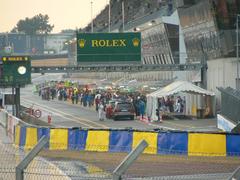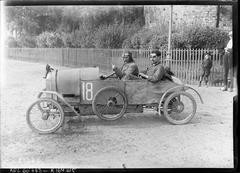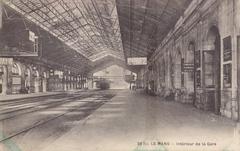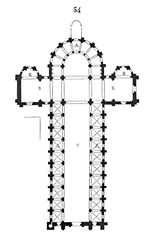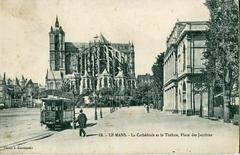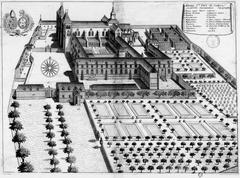
L’Abbaye de l’Épau: Complete Visitor Guide—Hours, Tickets & History (Le Mans, 2025)
Date: 04/07/2025
Introduction
Nestled along the tranquil banks of the Huisne River near Le Mans, L’Abbaye de l’Épau is a remarkable emblem of both medieval heritage and contemporary cultural life. Founded in 1229 by Queen Berengaria of Navarre, widow of Richard the Lionheart, this Cistercian abbey invites visitors to explore its elegant 13th-century Gothic architecture, rich royal legacy, and vibrant calendar of artistic events. From its storied past through centuries of transformation to its present role as a thriving cultural hub, L’Épau Abbey stands as a testament to the enduring spirit of French history and creativity. This guide brings you essential details on visiting hours, tickets, accessibility, architectural highlights, restoration, and upcoming events—everything you need for a memorable visit to one of Le Mans’ premier historical sites (France Voyage; Abbaye de l’Épau Official Site; Le Mans Tourisme).
Contents
- Historical Overview
- Architecture & Layout
- Restoration & Conservation
- Visiting Information: Hours, Tickets, Access
- Guided Tours & Visitor Tips
- Cultural Events & Contemporary Role
- Nearby Attractions
- Frequently Asked Questions (FAQ)
- Summary & Recommendations
- Sources
Historical Overview
Foundation and Royal Patronage
L’Épau Abbey was founded in 1229 by Queen Berengaria of Navarre, who sought spiritual solace and a lasting legacy after the death of her husband, Richard the Lionheart. She chose a secluded site near Le Mans, in line with Cistercian ideals of simplicity and isolation. The abbey’s establishment reflected the cross-channel ties between English and French royalty in the Middle Ages (France Voyage; Wikipedia).
Medieval Growth and Conflict
The abbey was constructed in the traditional Cistercian style, with a church, cloisters, chapter house, dormitory, and scriptorium set within a vast park. During the Hundred Years’ War, the abbey suffered significant damage; in 1365, locals set it ablaze to prevent enemy occupation. Restoration efforts, supported by royal taxes and the local bourgeoisie, continued well into the 15th century (Wikipedia).
Decline, Secularization, and Modern Revival
Monastic life at L’Épau declined by the 18th century. The abbey was sold and repurposed as a farm, then further transformed after the French Revolution. Despite these changes, the complex retained its historic character and became recognized as a protected monument (Le Mans Country Club).
During World War II, the site served as a prisoner-of-war camp. In 1958, local authorities purchased the abbey and launched a major restoration campaign, culminating in its transformation into a celebrated cultural venue by the 1990s (Wikipedia).
Architecture & Layout
Cistercian Design Principles
The abbey’s architecture exemplifies the restrained yet harmonious style typical of the Cistercian order. Buildings are arranged around a central cloister, and the location was chosen for its isolation and proximity to water, requiring significant land reclamation (Abbaye de l’Épau Official Site).
Construction & Materials
The monks used local materials, including gré roussard sandstone, tuffeau limestone, and Bernay stone, resulting in warm, earthy tones and a robust structure that blends with its natural setting.
Key Features
- Abbey Church: Consecrated in 1234, it features pointed arches, ribbed vaults, and a flat chevet. Original spires and buttresses are gone, but the nave, side chapels, and rose window remain highlights.
- Cloister & Monastic Buildings: The cloister is bordered by the chapter house (with elegant ribbed vaults), dormitory, and refectory. Portions have been altered but retain original elements.
- Abbot’s Lodging: 16th-century modifications show a progression from monastic austerity to greater comfort.
- Frescoes: Fragments of medieval paintings survive in the sacristy and other spaces, offering glimpses of the abbey’s decorative scheme.
Restoration & Conservation
Early Damage and 20th-Century Rescue
Repeated damage during wars and neglect led to significant disrepair. In 1959, the Sarthe department acquired the abbey and began a careful restoration, using original materials and techniques to honor its 13th-century origins.
- 1925: Key structures classified as historic monuments.
- 1961, 1973, 2005: Expansions of heritage protection.
- Since 2016: Managed by Sarthe Culture, supporting ongoing conservation and adaptive reuse (Le Mans Country Club).
Sustainability
The abbey’s 13-hectare park now features permaculture gardens, medieval vegetable plots, and sustainable management. The on-site café uses produce from these gardens, supporting local traditions of self-sufficiency.
Visiting Information: Hours, Tickets, Access
Hours & Admission
- Opening Days: Open Tuesday to Sunday (closed Mondays except for group visits outside school holidays, Zone B).
- Hours: 10:00 AM – 6:00 PM (last entry at 5:30 PM); hours may vary for holidays and events (Abbaye de l’Épau Official Site).
- Tickets: Adults ~€8; discounts for students and seniors; children under 12 usually free. Some exhibitions or events may affect prices (Sarthe Tourisme).
Getting There
- By Tram: Line 2 toward Espal-Arche de la Nature, stop at “Gué Bernisson.”
- By Bus: Line 6, “Gué Bernisson” stop.
- By Car: Free parking on-site.
- By Bike: The Boulevard Nature cycling route connects the abbey with central Le Mans (Budget Your Trip).
Accessibility
Most public areas are wheelchair accessible, including restrooms and major exhibition spaces. Contact the abbey for detailed information or assistance.
Guided Tours & Visitor Tips
- Guided Tours: Available in French and English (reserve ahead for English tours).
- Self-Guided Visits: Informative panels and audioguides support independent exploration.
- Family Activities: “Adventurer’s notebook” for children, plus educational workshops.
- Photography: Allowed for personal use; flash and tripods may be restricted.
Travel Tips
- Best times: Spring and autumn for mild weather and beautiful gardens.
- Comfortable shoes recommended due to uneven surfaces.
- Check the calendar for concerts, exhibitions, and special events before visiting.
Cultural Events & Contemporary Role
Festival de l’Épau
The abbey is home to the renowned Festival de l’Épau, held each May. This week-long event features acclaimed classical musicians and contemporary ensembles, with performances in the main church and cloister. The 2025 edition (May 20–27) includes premieres and collaborations with leading composers (Diapasonmag).
Year-Round Programming
The abbey hosts concerts, visual art exhibitions, workshops, and community festivals, including the Siestes Teriaki music festival and Christmas illuminations. Educational partnerships with schools and universities support ongoing learning and creativity (Le Mans Tourisme; All Events in Le Mans).
Nearby Attractions
- Le Mans Old Town (Cité Plantagenêt): Medieval streets and ramparts.
- Saint-Julien Cathedral: Romanesque and Gothic masterpiece.
- Circuit de la Sarthe: Home of the 24 Hours of Le Mans race.
- Arche de la Nature: Expansive park for hiking and family activities.
Frequently Asked Questions (FAQ)
What are L’Épau Abbey’s visiting hours?
Open Tuesday to Sunday, 10:00 AM–6:00 PM. Closed Mondays, except for pre-booked groups.
How much are tickets?
Around €8 for adults; children under 12 usually free. Reduced rates available; check the official website for current prices.
Is the abbey accessible?
Yes, most main areas are wheelchair accessible. Contact the abbey for specific needs.
Are guided tours available in English?
Yes, with advance booking.
Can I buy tickets online?
Yes, via the official site.
Is photography allowed?
Yes, for personal use; restrictions may apply during events.
Summary & Recommendations
L’Abbaye de l’Épau is a living cultural landmark, bridging medieval heritage and contemporary artistic expression. Visitors can enjoy Gothic architecture, the tomb of Queen Berengaria, tranquil gardens, and a dynamic calendar of events. Its integration with Le Mans’ natural and urban landscapes, commitment to sustainability, and welcoming visitor services make it a top destination for history lovers, art enthusiasts, and families alike. For the latest updates, visit the official website and consider downloading the Audiala app for guided audio tours and event information.
Sources
- France Voyage
- Abbaye de l’Épau Official Site
- Le Mans Tourisme
- Sarthe Tourisme
- Le Mans Country Club
- Diapasonmag
- Budget Your Trip
- All Events in Le Mans
- JDS Le Mans


